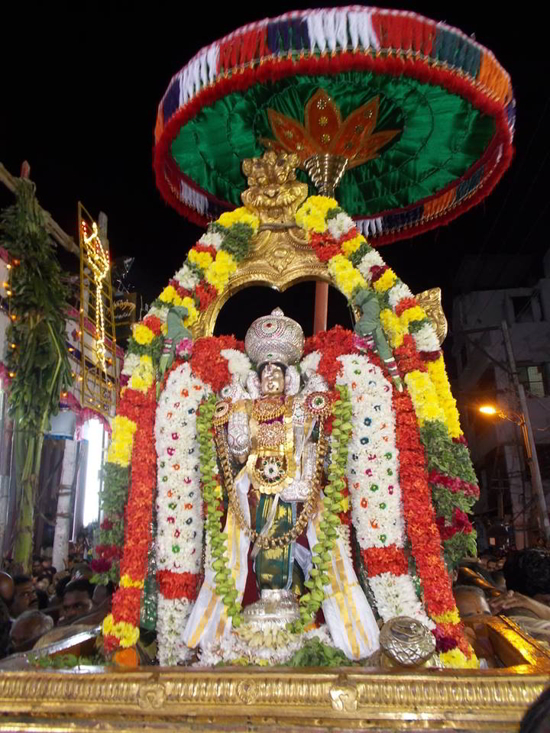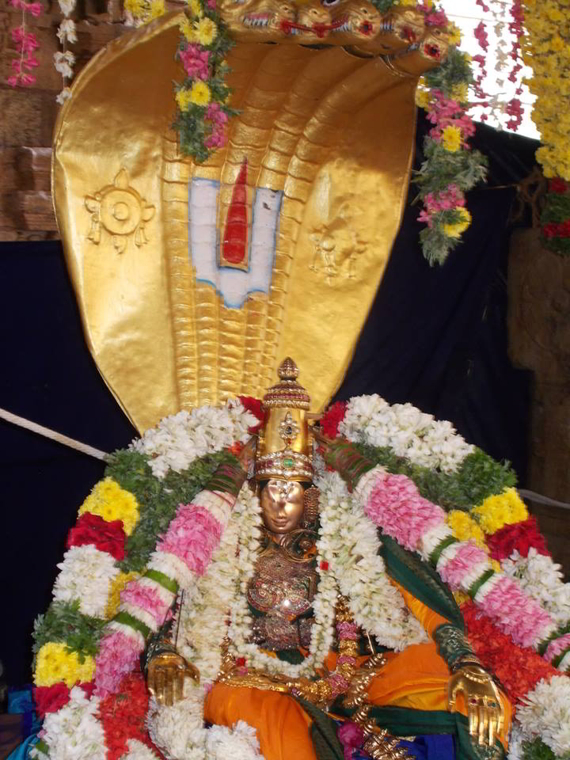Article by Sri Sadagopan Iyengar Swami, Coimbatore
What is a Stotra? It is usually a eulogy or tribute, generally in verse form, in praise of some one who is the object of admiration. By its very nature, a stotra permits some poetic licence for exaggeration. It allows considerable embellishment and magnification of the subject’s good looks or qualities. When we read that a lady’s face vanquished the moon in brightness and beauty, it is very obviously a “stotram”. Adiyen would like to narrate in this piece the different aspects of a Stotram.
If we were to take a count, the most common object of a Stotram, in all literature, religious and secular, would be the Lord Himself, irrespective of the religion to which the composer belongs. The maximum number of tributes would have been paid to the Lord, though some romantic souls might have devoted afew thousand words to their beloved or to nature. This would be perfectly in order, considering that it is the Lord who is the object of universal admiration and adulation.
There is however one important difference between a tribute to the Lord and that to others. In the case of human beings, stotram invariably involves exaggeration and embellishment. Where it concerns the Lord, any Stotram can at best be a gross understatement, for words, however powerful or profuse, can never be adequate to describe fully His greatness, or even a portion of it. This is brought out by Sri Koorattazhwan in SriStavam-

“Stotram nAma kim Amananti kavaya: yadyan yadeeyAn guNAn….. samyak sadya guNAbhi varNanam atO brooyu: katam tAdrusee”.
If we are to praise the Lord, why resort to a Stotram?
Why not keep reciting one or the other of His numerous and glorious names constantly, say “ Rama Rama” or “Krishna Krishna”? We read so much about the efficacy of chanting the Lord’s names and its capability of delivering us from mundane shackles. And the names are sweet enough to utter, as any proponent of nAma sankIrtanam would attest.
To the dynamic human intellect, any repetition is boring and tedious, even if it is of the Lord’s haloed name. It is much easier to recite a stotram than to repeat a mere tirunAmam. Moreover, a name could possibly convey only certain limited aspects of His greatness, whereas a Stotram could do much greater justice to the Lord and His auspicious attributes. Thus reciting a stotram affords the devotee much more enjoyment than mere recitation of His names. Stotras generally conformto a specific metre (chhandas), often lilting and pleasurable, adding to the enjoyment of the subject. Thus Srimad Valmiki Ramayana is acclaimed as one such stotra (admittedly of epic proportions), full of enchanting rhyme, rhythm and rhapsody- “tat upAgata samAsa sandhi yOgam sama madhuraOpanatArttha vAkya baddham- Raghuvara charitam”.
Another beauty of stotras (with afew exceptions) is that they can be recited and enjoyed by anybody, irrespective of caste, creed, gender and age. Vedas can be recited only by those eligible therefor, and uttering some mantras too is subject to qualifications. Stotras do not impose any such restrictions on anybody, and are open to all universally.
In their infinite mercy, our Acharyas have ensured that the esoteric and often impregnable fortress of knowledge is thrown open to everyone without discrimination, by reducing extremely subtle and complex concepts to easily- comprehensible stotra formulations. Stotras do not also impose any qualifying restrictions on the composer. All that is required is a deep sense of devotion and familiarity with the rudiments of composition.
However, considering the magnificence of the subject (the Lord) and our own severely limited faculties, we might despair of authoring a stotram. Better people than us have endured this feeling, overcome it and composed beautiful stotras, which inspire us till today. The Ganga might be the holiest of rivers and a mighty one at that, but that does not prevent a dog from slaking its thirst with a sipof its waters. In the process, while the Ganga does not lose its sanctity one bit and remains unsullied, the dog is able to satisfy its thirst and achieve emancipation by association with the holy river. Similarly, stotras can be composed by even those in the lowest strata, socially, economically or otherwise.
Says Sri Alavandar, “ in the matter of praising you, both the exalted Brahma and lowly myself are on the same footing, for both know not the true extent of Your greatness. When the deep ocean submerges a small stone as well as a tall mountain, the difference between the two disappears. Hence I too venture to compose a stotra on You”. (“kO majjatO: aNu kula achalayO: visEsha:?”).
Considering our limited capabilities to adequately mirror His qualities, the Lord Himself comes to our rescue many a time and composes the stotra Himself, using us as mere output devices. Sri Nammazhwar says that Tiruvaimozhi was composed by the Lord Himself-“tAnE yAn enbAn Agi tannai tAnE tuditthu”, “ yAnAi tannai tAn pAdi tennA ennum en ammAn”. Sri Vishnu Sahasranamam also attests to this by acclaiming the Lord as “StOta”(the Divine Bard).
Coming to the subject matter of stotras, Sri Nammazhwar is quite emphatic that adulations should not be addressed to anybody but the Lord, for only He is deserving of praise-
“en nAvil in kavi yAn oruvarkkum kodukkilEn”. Any praise of decadent human beings is just a pack of lies, says he-“vaLLal pugazhndu num vAymai izhakkum pulaveergAl”. He refuses to sully his tongue by singing the praise of humanity-“vAi koNdu mAnidam pAda vanda kaviyEn allEn”. At the next level, the Azhwar states categorically that even among deities, only Sriman Narayana is praiseworthy, and no other demigod- “em AdippirAn nirka matrai deivam viLambudirE”. Swami Desikan too decries the poets’ habit of praising anyone but Emperuman-“narEndra chAtu rachanA dhanyAm na manyAmahE”.

Sri Vishnu Sahasranamam emphasizes the uniqueness of the Lord as an object of praise, by calling Him “Stavya:”.
Sri Nammazhwar highlights the fact that no stotra, however prolific or profuse, can ever hope to encompass the Lord’s beauty or auspicious attributes, even if the Lord Himself were to be the composer, and even if the entire world were to join Him in the endeavour-
“Yanum Etthi Ezhulagum mutrum Etthi-pinnum
tAnum Etthilum tannai EtthaEttha engu eidum?”.
யானும் ஏத்தி ஏழுலகும் முற்றும் ஏத்தி, பின்னையும்
தானும் ஏத்தி லும்தன்னை ஏத்த ஏத்த எங்கெய்தும்,
தேனும் பாலும் கன்னலும் அமுதுமாகித் தித்திப்ப,
யானு மெம்பி ரானையே ஏத்தி னேன்யா னுய்வானே.
– (மூன்றாந் திருமொழி)
If one can never hope to truly cover even one of His attributes fully through one’s stotra, why should one try at all, and why not abandon it as a futile endeavour? “Even if that is so, I am unable to refrain from the exercise, and consider it to be my duty or “SvarUpam” to praise the Lord.” Says the Azhwar-“Yanum empirAnayE EtthinEn yAn uyvAnE”.
The Lord’s magnificence is such that volumes can be written about His each attribute or body part. We thus have Swami Desikan’s “Daya Satakam”, comprised of a hundred slokas devoted to a single divine attribute, Mercy. And the same distinguished author has givenus the”Paduka Sahasram”, a thousand slokas on His footwear, composed overnight! We also have thematic stotras, such as the “PanchAyudha Stotra”, in praise of the Lord’s weapons, a head-to-foot portrayal of Sri Rangaraja in “Sri Bhagavat DhyAna SopAnam”, the Superhuman exploits of the Lord belying His human form, in “Sri atimAnusha Stavam” of Sri Koorattazwan, a treasure-chest of the Divine Consort’s attributes in Sri Bhattar’s “Sri GuNaratna Kosam”, master piece compositions on Sharanagati, the Lord’s splendorous reign in Sri Rangam and Sri Vaikuntam in the three GadyAs of Bhagavat Ramanuja, and so on.
As a natural corollary, mahAns have composed stotras on several Acharyas too, as a hallmark of their devotion for the latter. Sri Madhurakavi leads the ensemble with his “KaNNinuN siru thAmbu”, in which he declares praise of the Acharya to be greater than that of the Lord Himself. He is followed by distinguished Acharyas like Sri Tiruvarangatthu amudanAr with his “irAmAnusa nootrandAdi”, Swami Desikan with his “etirAja Saptati”, Sri Manavala Mamunigal with his “eitrAja Vimsati”,and numerous others with similar stotras of distinction.
To conclude, Stotra is the natural outlet for a devotee who is so overwhelmed with some aspect of the Lord’s greatness, that he cannot remain without eulogising the Lord. It would appear that a stotra on Emperuman is no less greater than Himself, for the Sahasranamam describes Him as the embodiment of the Stotra itself. The sobriquets “Stuti:” and “StOtram” elevate the Stotra to such high levels, that one feels that Stotras themselves deserve profuse paeans of praise!
Article by Sri Sadagopan Iyengar Swami, Coimbatore









Wonderful explanation! one more feather in the cap of Sri Sadagopan Iyengar Swami for providing the such an amrutham or nectar for the thirsty minds of all devotees…
Thank you so much for the beautiful pictures of Koodal and Kallazhgar on Vaikunta Ekadasi day. They are not only a feast to the eyes of a devotee,but is so apt that during this month of margali.It reminds us of Periyalwar who sang Pallandu to Lord Koodal Azhgar and Sri Andal who prayed to Lord Kallazhgar saying that she would offer ‘100 pots of butter and 100 pots of sweet pongal’ which can be found in her nAcciyAr thirumozhi,if the Lord came down and accepted her hand in marriage.
nARu naRumpozhil mAlirunjcOlai nambikkunAn
nURu taDAvil veNNey vAynErndu parAvivaittEn
nURu taDAniRainda akkAravaDisil sonnEn
ERu tiruvuDaiyAn inRuvandivai koLLungolO
nAcciyAr thirumozhi – verse9.6